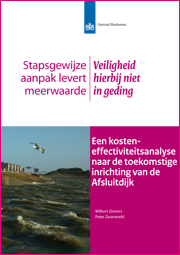A cost-effectiveness analysis to prepare the „Afsluitdijk‟ for the future
CPB: Stapsgewijs opknappen Afsluitdijk voordelig en veilig

We are sorry, unfortunately there is no English translation of this page.
The Afsluitdijk (Dutch for „closure dike‟) protects the northern part of the Netherlands from the sea. One of these minimal requirements is the present statutory safety regulation that states that this dike must withstand water levels which occur once every ten thousand years. Many (welfare) effects are analysed, such as construction costs, maintenance costs, cost of energy, CO2 emissions, effects on nature and landscape. Specific attention has been paid to the effects on drinking water supply and the value of (additional) safety for people living in the neighbourhood of the two major lakes (IJsselmeer en Markermeer) for which the Afsluitdijk provides protection from the dangers of flooding. In addition, flexibility of project alternatives towards future uncertain climate changes is addressed in a real option approach.
One of the conclusions is that the policy-decision process should not opt for one of the six investigated alternatives, but should compose an „optimal‟ alternative based upon the elements of these six alternatives. Therefore, the pros and cons of these individual elements are presented separately. Especially, optimal water control requires additional attention and could lead to substantial cost savings. The question concerns whether to continue the current draining of water into the sea or to (partly) switch toward pumping of excess water.
Authors
